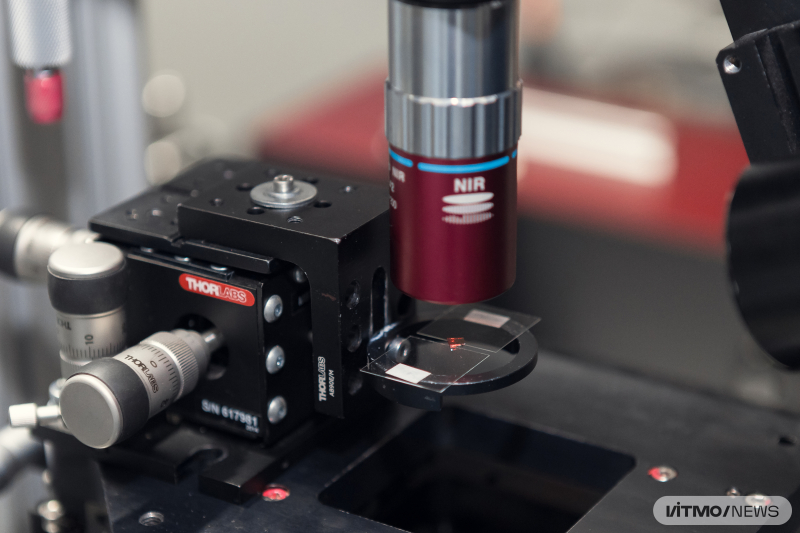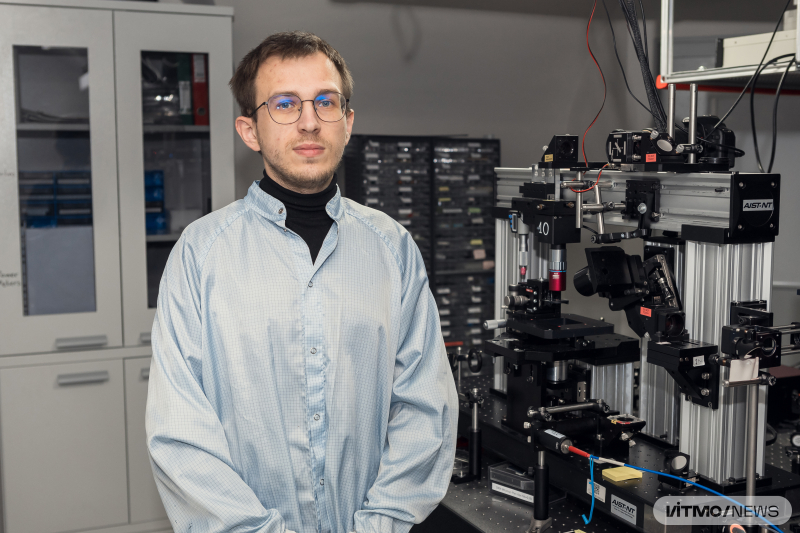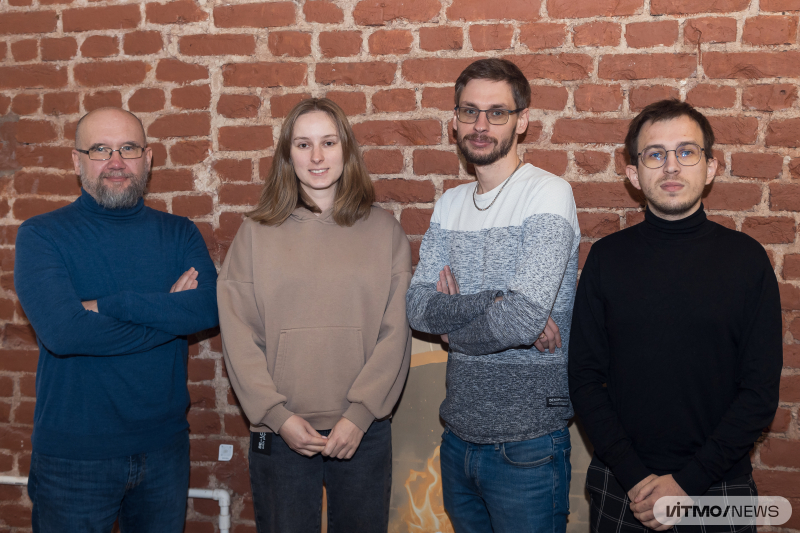A team of scientists from ITMO University have developed a record-thin device that decreases the wavelength of a laser beam by threefold. The process, known as the third harmonic generation, is now more efficient thanks to a 20 nm-thick film made of chalcogenide alloys that generates radiation in a wide range of wavelengths without amplification by nanoresonators and performs 100-1,000 times better than similar devices. The technology will be useful in further research related to tissues and cells in laser scanning microscopes and signal processing in photonic integrated circuits for quantum communication. The corresponding article is published in Laser & Photonics Reviews.

An optical installation for generating and detecting the third harmonic. Photo by Dmitry Grigoryev / ITMO NEWS
Harmonic generation is a nonlinear optical process in which a laser beam passes through a nonlinear crystal, causing the wavelength of the light to reduce. The order of the harmonic is determined by the size of this reduction: second, if it decreased by twice, third – if it decreased by threefold. For instance, an infrared ray with a 1,064 nm wavelength that is invisible to the human eye becomes visible green light with a 532 nm wavelength after the second harmonic generation and an invisible ultraviolet ray with a 341 nm wavelength following the third harmonic generation.
The third harmonic generation finds use in biophotonics and medicine. Scientists can examine the structures of biological tissues and cells without having to use dyes and various laser scanning microscopes, since ultra-short ultraviolet pulses excite fluorescence in these materials.
Nevertheless, there are so far no efficient sources of the third harmonic generation. To simulate the process, specialists have to use expensive and often bulky (up to half a meter in width) multi-wavelength systems. In these systems, a laser beam and the second harmonic generated by this beam travel through a nonlinear crystal where their frequencies add up, resulting in a wavelength equal to the third harmonic. The efficiency of such generation is, however, extremely low – only 2-3% of the original beam is converted into the third harmonic. Different teams are working to produce nanometer sources of the third harmonic based on resonant metasurfaces, yet they all still lack efficiency.
Researchers at ITMO’s Faculty of Physics, along with their colleagues from the National Research University of Electronic Technology, designed a switchable and compact third harmonic generation source that is 100-1,000 times more efficient when compared to similar nanometer devices. The secret is in thin films based on a chalcogenide alloy of germanium, antimony, and tellurium (Ge2Sb2Te5, or GST), which gained widespread popularity after being used in DVDs and optical memory components. One of its features is phase-changed memory: when exposed to laser radiation, GST films switch back and forth between amorphous and crystalline states and change their optical properties.
“The typical materials used to create third harmonic sources are different 2D materials or metasurfaces; however, even if they are turned into resonant nanostructures for generation amplification, they still lack in efficiency – 10-11-10-7 depending on the material used. Our solution is a thin film made of a germanium-antimony-tellurium alloy, which, due to its properties, generates the third harmonic 100-1,000 times more efficiently than other resonant nanometer devices. In the amorphous phase, this film converts infrared radiation into the third harmonic with an efficiency of 9×10-6 across a broad visible spectrum – from purple to orange (349-615 nm). Whereas in the crystalline phase, the optical properties of the film change significantly, making the generation less noticeable up until it completely fades away,” explains Artem Sinelnik, a team lead and a researcher at ITMO’s Faculty of Physics.

Artem Sinelnik. Photo by Dmitry Grigoryev / ITMO NEWS
Such high performance was made possible also due to the size factor. The developed device is quite compact, given that the film alone is 20 nm-thick and with a substrate – around 180-200 μm, which is similar to the thickness of human hair.
“Other metasurface devices are approximately 400-600 nm-thick, while our films are only 20 nm, which also has a positive impact on efficiency. The thinner the film in the amorphous phase, the more efficient the generation. So, it’s safe to say that our technology is in line with the trend towards miniaturized applied devices,” notes Daniil Litvinov, an author of the paper and a PhD student at ITMO’s Faculty of Physics.

Daniil Litvinov. Photo by Dmitry Grigoryev / ITMO NEWS
A compact yet high-efficient device for the third harmonic generation could potentially replace several radiation sources in laser scanning microscopes and improve image resolution. Additionally, phase-based generation may be used to encode information: 1 is for harmonic generation in the amorphous phase and 0 is for no generation in the crystalline phase. According to the developers, the device supports up to a million switches between phases and performs that in just 10 nanoseconds, which may be of help for photonic integrated circuits that process optical signals in quantum communication.

The research team (left to right): Alexey Yulin, Olga Kushchenko, Artem Sinelnik, and Daniil Litvinov. Photo by Dmitry Grigoryev / ITMO NEWS
The research is supported by the national program Priority 2030 and the Russian Science Foundation grant No. 24-72-10038.
